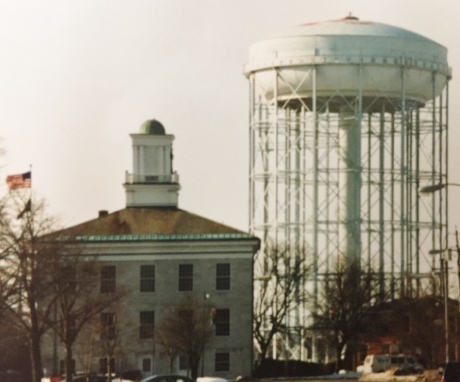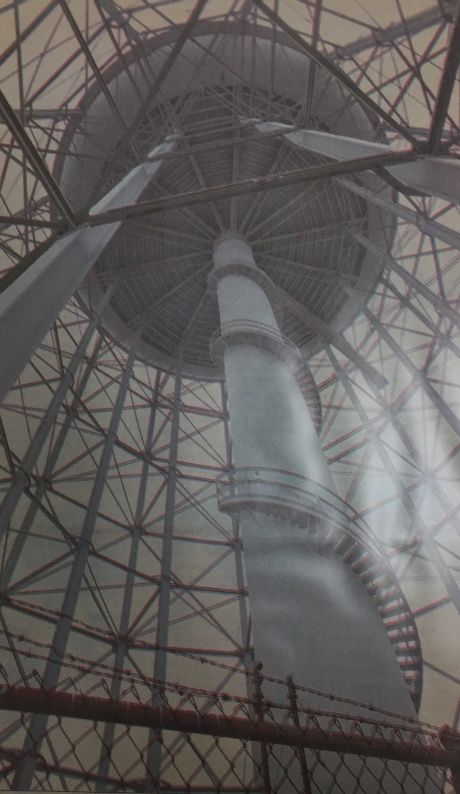Climbing the Batavia Water Tower was a 'double dog dare'

Teenagers have most likely been doing risky adventures since ancient times. It's their way of rebelling and trying new things.
Prehistoric teens might having taken dad's newly invented wheel for a joyride down the highest sand dune. Or they could have covered some cave paintings with graffiti.
In the '50s and '60s in Batavia, drag racing on the Creek Road or jumping off the Walnut Street Bridge into Tonawanda Creek were things kids would do that parents certainly wouldn't have been happy about if they had known.
One of the rites of passage into daring teenhood that my friends and I did was climb the Batavia Water Tower on Ellicott Street.
If you lived or worked in Batavia between 1939 and 2003 you would have seen the Water Tower jutting above the city skyline. Located on Ellicott Street behind the E. N. Rowell Box Factory and Engine House #1 of the City Fire Department, it was on the bank of Tonawanda Creek and very near to downtown.
Built in 1938-39 as a project for W. P. A. (the Works Progress Administration was renamed the Work Projects Administration) at a cost of $175,000 ($3 million in today's money) the tower was short-term insurance in the event of a break in the city's water supply.
Just shy of 200 feet high (17 stories) it was believed at the time of its construction to be the tallest water tower in the United States. The blinking red lights on top were to alert low-flying aircraft. It held 1.5 million gallons, or 13 million pounds, of water.
In 1983 it was repainted at a cost of $89,000. In 2003, the 65-year-old rusting structure was no longer needed and was disassembled and taken down at a cost of $114,000.
From the day it was finished, the Batavia Water Tower must have been a challenge to the teenage ego, or maybe even to younger youths; in 1952 four boys between the ages of 10 and 14 were discovered up there by police in broad daylight. They told police they wanted to see Lake Erie, but were disappointed that they couldn't even see Lake Ontario.
For my friends and me it was akin to Flick in “A Christmas Story” accepting the “double dog dare” and sticking his tongue on a frozen flagpole. None of us really wanted to go up the tower. But, in the code of teens, none of us could get out of climbing it if someone else did without severe repercussions to our reputation. In other words, we'd rather be scared than called chicken.
I don't know about the others, but I had to block out my fear of heights, which I still have to this day. Not exactly as bad as Indiana Jones and snakes, but worse than flying on a commercial airline.
At least we weren't brazen enough to climb in the daytime. That would have resulted in a ride in a patrol car immediately. Plus, half the fun was getting away with it and not telling your parents until you were 40.

So, we would sneak back there in the dead of night. The darker the better. First, there was a fence to climb over. “Danger” and “Warning” signs were posted on the fence, but that just made it more inviting. Then, you had to hoist yourself up to a spiral staircase, which wound around the core of the tower. That part was actually not bad as it had solid steps and handrails, so if you didn't look down it was bearable.
At the top of the spiral stairs was a circular walkway which went all the way around. This part also had a railing and I could handle it if I kept my back against the wall and didn't look over the side. Those who have a fear of heights will identify with the weak feeling I would get in my legs just watching one of my braver buddies look down over the railing.
I imagine there was a fine view of the surrounding area from there in the daytime, but all we could see were the lights of downtown and surrounding buildings like the Doehler-Jarvis plant, a tool-and-die company, just to the south. (It employed 1,500 people in its heyday and closed in 1981. The buildings were later razed to make way for parking around the ice-skating rink.)
The biggest challenge though was negotiating an arced ladder that had no handrail and which curved over the top and took you up to the lights on the apex of the structure.
With trembling hands, up we would go. Once we grabbed onto the lights flashing in our face like a drowning person to a piece of driftwood, we could relax for a few minutes and enjoy our conquest. We would light up a cigarette (another thing our parents would frown on even though most of them smoked, too) and gloat in our accomplishment.
One time, we had to snuff our smokes quickly and remain very silent as we observed a policeman on foot checking on the cars in Mancuso's used car lot just below the tower. We had to stay up there longer than usual while he completed his rounds and finally left. We undoubtedly breathed a sigh of relief and tried to enjoy the moment without thinking about the trip back down.
Going back down that curved ladder was absolutely the hardest part for me. You could not negotiate the ladder going over the edge without looking down at least briefly. If that cop had still been there he could have probably heard my heart pounding.
Once back on the walkway, you could begin your descent of the spiral staircase. Holding tightly onto the railings, I would try to look straight out and not down.
As I got to the bottom of the stairway I would almost be running and then as I hopped onto the ground a huge feeling of relief would wash over me -- “I made it, I'm still alive!”
As I walked home, I would tell myself, “OK. That's it. I don't care what the guys say or how much grief they give me, I am never going up there again.” Of course, I did care, and the next time I'd go again. Except for the force of nature, I'm not sure there is anything more powerful than peer pressure.
It was more than 50 years ago, and I don't remember how many times I climbed the water tower. Certainly five or less. But, considering my fear of heights it's still a perverse badge of honor of my teen years.
When the Batavia Water Tower was being taken down in 2003, my dad was a resident of the New York State Veterans Home and I would go to Batavia twice a week to visit him. When the last of the tower was lying on the ground waiting to be taken away to scrapyards, I stopped by there and got as close as I could.
"Hah! You're not so high and mighty now are you?” I laughed.
But still every time I go out on a bridge or the balcony of a high story hotel room, I know that tower is laughing back at me.
Photos of the Batavia Water Tower courtesy of Judy Stiles at the Genesee County History Department.
